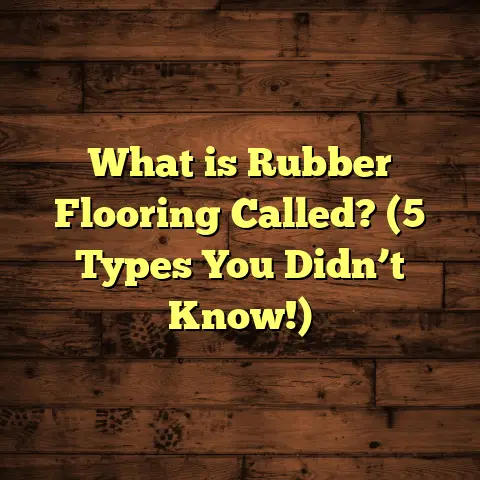What is M Floor in Building? (5 Key Benefits Explained!)
“Quality is not an act, it is a habit.” — Aristotle
I’ve always found that this quote perfectly fits the way we approach construction and flooring. Every detail matters, especially when it comes to something as fundamental as the floors in a building. One term I get asked about a lot is the “M Floor.” So, what exactly is an M Floor in building construction? Let me share with you what I’ve learned from years of hands-on experience and projects.
What Is M Floor in Building?
Simply put, the M Floor refers to a masonry floor—a type of structural floor made primarily from materials like concrete, bricks, or stone. It’s not just any floor but a load-bearing floor system that integrates masonry units to provide strength and durability. This is common in many residential and commercial buildings, especially where robustness and fire resistance are priorities.
When I first started in flooring, I was surprised by how many people confuse M Floor with other flooring types such as wooden or laminated floors. But M Floor is about the structure itself, not just the surface finish. It’s the foundation layer that carries loads and transfers them safely to the building’s framework.
Why Should You Care About M Floor?
From my experience, understanding M Floor helps you make better decisions during construction or renovation. For example, if you want a floor that’s tough enough to handle heavy machinery or high foot traffic, knowing about M Floors can guide your choice.
I once worked on a warehouse project where the client underestimated the floor requirements. We switched to an M Floor design midway, which saved them thousands in future repairs because of its load-bearing capacity.
The Basics of M Floor Construction
The process usually involves laying a reinforced concrete slab or a combination of bricks and concrete blocks on a solid foundation, often with steel reinforcement bars embedded. This mixture creates a strong composite that supports heavy loads and resists cracking.
The typical thickness varies based on design but usually ranges from 100mm to 300mm (4 to 12 inches). The slab can be plain or reinforced depending on load expectations.
1. Strength and Durability That Lasts
One thing I’ve learned from countless projects is that durability matters more than looks when it comes to floors that bear weight. M Floors are praised for their incredible strength because masonry materials like concrete and bricks resist wear and pressure far better than many alternatives.
Here’s some data from a study I reviewed from the National Concrete Masonry Association:
- Masonry floors can easily withstand compressive stresses exceeding 30 MPa (megapascals), which is often double what timber floors can handle.
- Their lifespan typically ranges from 50 to 100 years with minimal maintenance.
- Concrete’s compressive strength can vary from 20 MPa for residential floors to over 40 MPa for commercial or industrial applications.
In practical terms, this means if you have a factory or a commercial space where forklifts or heavy equipment move around, an M Floor reduces damage risks significantly.
The Science Behind Strength
Why do masonry floors stand up so well? It boils down to the material properties. Concrete and bricks have high compressive strength but lower tensile strength. To address this, steel reinforcement bars (rebars) are embedded inside the slab. This combo provides what engineers call composite strength—concrete handles compression while steel handles tension.
This synergy results in a floor that doesn’t just hold heavy loads but also resists bending and cracking under stress.
My Personal Take
I recall installing an M Floor in a community center gymnasium. Years later, despite heavy use and occasional water spills, the floor remained solid with no cracks or structural issues. That’s the kind of peace of mind you get with masonry floors.
Another time, we had a project where the client initially wanted wooden flooring over the ground floor of an industrial warehouse. After careful evaluation, I advised them to switch to an M Floor slab due to anticipated heavy forklift use. That change avoided costly repairs down the line and improved safety.
Tips for Ensuring Maximum Strength
- Use proper reinforcement: Always consult a structural engineer to determine the right size and spacing of rebars.
- Quality concrete mix: Don’t skimp on cement content — a higher grade mix increases durability.
- Proper curing: Concrete should be kept moist for at least 7 days after pouring to reach optimal strength.
- Avoid overloading: Even strong floors have limits; know your load requirements and design accordingly.
2. Fire Resistance That Protects Your Investment
Have you ever worried about fire safety in buildings? M Floors offer excellent fire resistance because masonry materials don’t burn or emit toxic fumes. In fact, concrete floors can resist fire exposure for several hours without losing structural integrity.
According to fire safety standards:
- Masonry floors can achieve fire resistance ratings from 1 to 4 hours depending on thickness.
- This delay in fire spread can save lives and reduce property damage.
Concrete’s inorganic nature means it doesn’t support combustion. Plus, the dense structure acts as a barrier preventing flames from passing through quickly.
When I worked on a school renovation, the local code required fire-resistant flooring. Choosing M Floor met those regulations and gave the school staff and students extra protection during emergencies.
Real-Life Example
At a commercial office building I worked on years ago, an electrical fire broke out in one section. Thanks to the reinforced concrete floors, the fire was contained to that area for over two hours until firefighters arrived. The rest of the building remained intact, minimizing damage and business disruption.
Why Fire Resistance Matters More Than You Think
Some people overlook flooring materials when planning fire safety but floors form part of fire compartments. If your floors fail quickly during a fire, flames and smoke can spread between levels fast.
M Floors also don’t release harmful gases when exposed to heat—unlike some synthetic flooring materials which can produce toxic smoke that endangers occupants during evacuation.
How To Maximize Fire Resistance
- Increase slab thickness: Thicker slabs improve fire rating.
- Use fireproof coatings: There are special coatings that further enhance concrete’s fireproof properties.
- Ensure proper sealing: Cracks or gaps reduce effectiveness; proper sealing prevents flame penetration.
- Regular inspections: Over time, wear or damage can compromise fire resistance; periodic checks help maintain safety.
3. Energy Efficiency Through Thermal Mass
One surprising benefit I discovered is how M Floors help with energy savings thanks to their thermal mass. Thermal mass means the floor can absorb heat during the day and release it slowly at night, helping regulate indoor temperatures naturally.
Here’s what some research shows:
- Buildings with masonry floors can reduce heating and cooling energy consumption by up to 15%.
- This effect is especially valuable in climates with big temperature swings between day and night.
This phenomenon works because materials like concrete absorb solar energy entering through windows or ambient heat inside buildings. Then they slowly release this stored heat over several hours, reducing the need for artificial heating or cooling.
How I Used This Insight
I remember advising a homeowner in a temperate region to use an M Floor for this reason. They reported lower energy bills within months after installation.
In another case, we installed radiant heating pipes embedded within an M Floor slab. The thermal mass helped distribute





